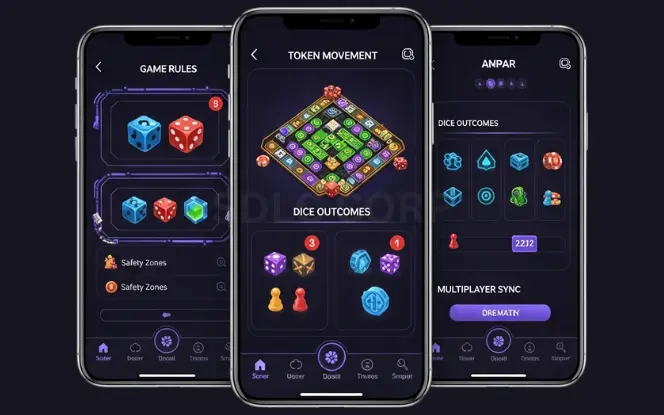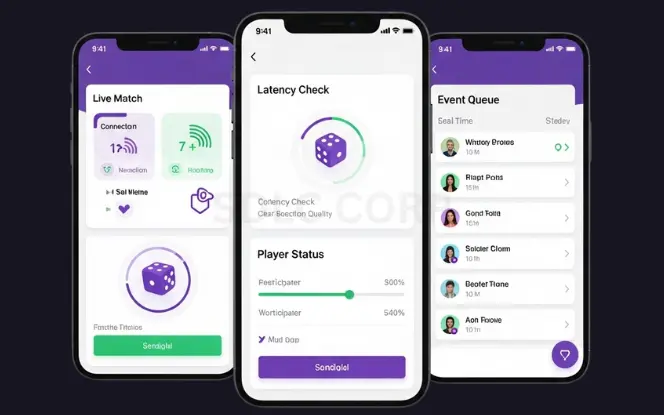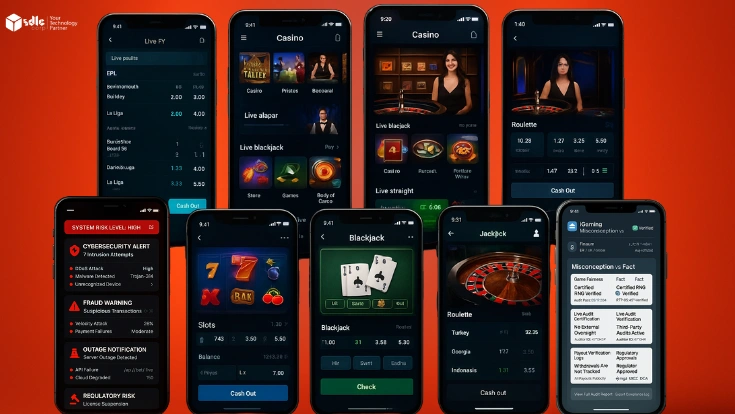Ludo may seem like a simple game, but developing a competitive Ludo app involves a wide range of complex challenges. From syncing multiplayer sessions in real-time to building secure, scalable servers and ensuring long-term user engagement, developers face numerous obstacles along the way.
This blog outlines the most critical Ludo game development challenges and provides actionable insights for overcoming them.
Game Logic and Rule Engine Complexity

Ludo may seem like a straightforward game governed by dice rolls and token movements. But replicating its logic digitally is far from easy.
One of the first Ludo game development challenges is designing a reliable and flexible rule engine. This engine must handle several aspects, such as:
- Player turns and token eligibility
- Dice outcomes and movement restrictions
- Token capturing and safety zones
- Multiplayer rules synchronization
The complexity increases when customization options (like quick mode or private rules) are introduced. Developers must test a vast number of permutations to ensure the rule engine behaves accurately across scenarios. Any flaw in logic can lead to unfair gameplay or user dissatisfaction.
Read more: Step-by-Step Guide to Develop a Ludo Game, from Idea to Launch
Real-Time Multiplayer Synchronization

Multiplayer is the soul of any Ludo game app. However, synchronizing real-time events between four or more players across different devices and networks is a core challenge.
Most issues arise from:
- Latency and packet loss
- Player disconnects and reconnections
- Synchronizing dice rolls, token positions, and chat
A player rolling a dice in India must reflect the action instantly for a player in Dubai or London. Managing these network calls with minimal lag and zero desync is critical for success in Ludo game app development. Server-based authoritative systems are often used, but they require careful implementation of event queues and rollback mechanisms.
Explore more: Building Multiplayer Ludo Games
Anti-Cheat Measures and Fair Play

One of the pressing challenges in Ludo game development is preventing cheating. While casual players may enjoy a light-hearted session, competitive users often try to exploit weaknesses for easy wins.
Common cheating scenarios include:
- Tampering with dice roll outcomes
- Multi-device playing to control multiple tokens
- Pausing or leaving the game strategically
Developers need to build server-side validation for every user action. The dice rolls should originate from a central server and be immutable. Additionally, detection systems should be implemented to flag suspicious behavior and take action—such as issuing bans or applying penalties.
Learn how: Game Mechanism For Ludo Game Mobile Apps
AI and Bot Behavior

Many players enjoy offline or single-player modes. Here, AI or bots substitute human opponents. While adding bots may seem simple, creating bots that mimic human decisions realistically is a significant challenge.
The bot must:
- Understand safe vs. risky moves
- Prioritize killing over movement
- Decide between unlocking a new token or moving an existing one
Explore more: Role of AI/ML in Ludo Games
UI/UX and Cross-Platform Compatibility

For any game to succeed, UI/UX must be smooth and intuitive. With Ludo being popular among all age groups—including children and seniors—developers must design interfaces that are both engaging and easy to navigate.
Challenges include:
- Creating accessible UI for all screen sizes
- Supporting Android and iOS with minimal UI bugs
- Designing game controls that are instinctive
Related read: Essential Features for Ludo Games in 2025
User Retention and Gamification Strategy

One of the most overlooked Ludo game development challenges is not just acquiring users, but retaining them. In an industry where thousands of games launch monthly, standing out isn’t enough—you need users to stay.
User retention in Ludo games often hinges on the ability to offer a rewarding experience through:
- Level systems and player progression
- In-app currencies, coins, and bonuses
- Daily login rewards and spinning wheels
- Referral bonuses and social integration
Dive deeper: Adding Social Features to Enhance Player Interaction and Engagement in Ludo Game
Monetization Without Compromising Experience

Another challenge in Ludo game app development is balancing monetization with player satisfaction. Ads and in-app purchases (IAPs) are standard revenue models, but intrusive ads or pay-to-win mechanisms often irritate users.
Some challenges faced here include:
- Integrating ad SDKs without affecting game flow
- Offering meaningful IAPs (like premium dice skins or custom boards)
- Ensuring IAPs don’t make the game unfair
Scalability and Server Infrastructure

A single-player game has fewer backend requirements. But Ludo, with its multiplayer feature, invites a load of challenges when thousands of concurrent users interact.
Some of the technical hurdles are:
- Managing real-time sockets at scale
- Handling peak loads during holidays or events
- Maintaining low server costs while ensuring uptime
Cloud infrastructure with auto-scaling and load-balancing mechanisms is crucial for Ludo game app development. Developers should also prepare for sudden user spikes driven by marketing campaigns or influencer collaborations.
In-Game Chat and Reporting Features

Social features are important in Ludo apps—particularly for players who enjoy friendly banter or want to taunt their rivals. However, integrating in-game chat comes with complications.
Challenges include:
- Preventing spam and toxicity
- Implementing profanity filters and user-blocking options
- Storing chat logs securely and managing reporting tools
Learn how: Adding Social Features to Enhance Player Interaction and Engagement in Ludo Game
Frequent Updates and Content Addition

Once a Ludo app is launched, the work doesn’t stop. Developers must plan regular updates to keep the game fresh and fix emerging bugs. But pushing updates introduces new challenges in Ludo game development.
Key issues include:
- Ensuring backward compatibility
- Rolling out features without breaking live games
- Performing hotfixes for live bugs without server downtime
Moreover, adding seasonal events, limited-time boards, or exclusive dice skins requires design, testing, and marketing coordination. Maintaining a content calendar becomes essential for long-term growth.
Handling User Feedback and Ratings

User feedback can be a goldmine or a nightmare. Reviews on app stores directly influence downloads. Developers must track, analyze, and act on feedback regularly.
The challenges are:
- Resolving complaints quickly
- Differentiating between real issues and device-specific bugs
- Managing reputation during downtimes or negative campaigns
Using tools for feedback analysis and a dedicated customer support system goes a long way in mitigating these risks and improving user retention in Ludo games.
Localization and Regional Features

Ludo is played across the world with slight variations in rules and terminology. Developers targeting a global audience must invest in localization.
Challenges here include:
- Translating the app in multiple languages
- Adjusting game visuals and colors for cultural sensitivity
- Regional event creation and local pricing strategies
Understand your audience: Demographics of Ludo Game App Users
Compliance with App Store Guidelines

Before any Ludo game goes live, it must pass the review processes of app stores. This introduces compliance challenges.
Developers must:
- Avoid copyrighted sounds, graphics, or game designs
- Clearly define privacy policies and data use
- Ensure no misleading in-app purchases
Failing compliance can lead to rejections or permanent bans from stores like Google Play or Apple’s App Store. It’s best to involve legal and QA teams early in the development cycle.
Testing and Quality Assurance (QA)

Lastly, no Ludo game can succeed without thorough testing. From unit tests to integration testing and multiplayer QA, everything must be watertight.
Testing challenges include:
- Simulating real-world network issues
- Testing across hundreds of device types
- Manual vs. automated testing balance
QA is not an afterthought. It’s a vital phase that identifies bugs, crashes, or gameplay glitches that ruin user experience and retention.
Conclusion
Building a Ludo game is not just about rolling virtual dice—it’s about orchestrating a fair, smooth, and enjoyable experience across a wide range of technical and user-centric domains. From user retention in Ludo games to network stability and compliance, the journey is filled with evolving priorities and challenges.
If you’re planning to develop a Ludo game app, make sure your strategies cover performance, design, monetization, and continuous improvement. These key elements define your app’s ability to thrive in a highly competitive mobile gaming space.
Contact us at SDLC Corp to turn your Ludo game idea into a successful reality.
FAQs
What Are The Main Challenges In Ludo Game Development?
The main challenges include creating a robust rule engine, ensuring real-time multiplayer synchronization, preventing cheating, and managing cross-platform compatibility. These obstacles require careful planning and testing to ensure a smooth and engaging user experience.
How Do You Ensure Fair Play In Ludo Game Apps?
To ensure fair play, developers implement server-side validation of dice rolls, use anti-cheat algorithms, and monitor user behavior. This helps prevent manipulation and guarantees a level playing field for all users.
What Are The Best Strategies For User Retention In Ludo Games?
Effective user retention strategies include offering daily rewards, implementing gamification features like progression systems and challenges, and creating in-app communities. Regular updates and social integration also keep players engaged and coming back.
How Can Ludo Game Developers Monetize Without Affecting User Experience?
Ludo game developers can monetize through optional in-app purchases like premium skins, coins, and ads that don’t disrupt gameplay. A balance between offering value and maintaining a fair game is essential to ensure user satisfaction.
What Are The Key Aspects To Consider For Cross-Platform Compatibility?
For cross-platform compatibility, developers should focus on responsive design, consistent UI/UX across devices, and seamless data syncing. This ensures that the game performs well on both mobile and desktop devices, creating a uniform experience for all players.



















